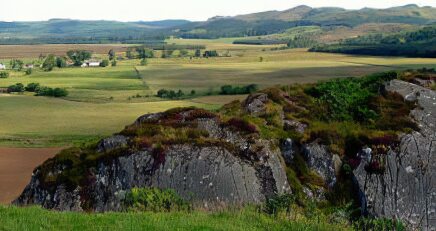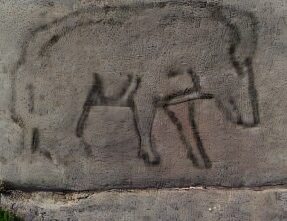Dál Riata
OS Grid reference:- NR 837 936
At the heart of the Gaelic kingdom of Dál Riata stood a formidable hill fort. The spectacular rocky outcrop of Dunadd near Kilmartin Glen in Argyll, one of the most famous historical sites in Scotland, has been occupied since the Iron Age.
Dunadd lay at the centre of the Dark Age Kingdom of Dál Riata, which stretched northwards to Ardnamurchan, west to northern Ireland and south to Arran and the Mull of Kintyre. The land surrounding the hillfort, now largely reclaimed, was in former times boggy and known as the Mòine Mhòr 'Great Moss' in Gaelic Celtic. This no doubt increased the defensive potential of the site.
Dunadd Hill Fort
Dunadd was far more than a defensive fortress. Dunadd, (Gaelic Dún Add, 'fort on the [River] Add') was the location where Gaelic kings were inaugurated in a ceremony that symbollically married them to the land. Just below the summit, a footprint carved into the rock is the most striking and evocative symbol of Scottish Kingship. Late medieval descriptions survive from both Ireland and Scotland which reveal the use of rockcut footprints in the process of Gaelic royal inaugurations and such footprint stones are known from various Irish royal sites. The seventeenth century Hebridean writer Martin Martin, explianed that the ceremony had been used for inaugurating the Lords of the Isles, as a symbol for the new Chief walking in the footsteps of his ancestors. Dunadd is known for its unique stone carvings below the upper enclosure, including a footprint and basin carved into the rock which are thought to have formed part of Dál Riata's coronation ritual.
Dunadd Boar Carving
On the same outcrop of rock is an incised boar. There are also a series of ogham scripts running along two of the split bedding planes and cracks that dissect the rock. The real purpose of all these carvings is unknown and the mysterious script remains undeciphered, it is assumed that they were used during inauguration ceremonies of kingship. The ogham inscription at Dunadd has been the subject of debate since it was first recognised in the 1950s. The initial interpretation was that it was an indecipherable Pictish inscription in a non-Indo-European language.
It is a complex fortification, defended by four lines of walling on different levels. These fortifications were constructed between 500 and 1,000 AD. The main approach to the fort is up a rocky defile to the lowest terrace which has a well-defined wall. Near the north end is a solidly built wall. Above this level, the walls are now in a more ruinous state. Entry was through a natural cleft in the rock sealed by wooden gates.
Dunadd is mentioned twice in early sources. In 683 the Annals of Ulster state:- 'The siege of Dún At and the siege of Dún Duirn'without further comment on the outcome or participants. In the same chronicle the entry for 736 states:-'Aengus son of Fergus, king of the Picts, laid waste the territory of Dál Riata and seized Dún At and burned Creic and bound in chains two sons of Selbach, i.e. Donngal and Feradach.
Dunadd has been excavated several times, which has have provided a glimpse of the use of the site through more than 1,000 years from the middle Iron Age to the early medieval period. The excavations have rendered a host of important finds which range from the sixth to the eighth centuries, including tools, quernstones, weapons, quernstones, imported pottery and moulds for the manufacture of fine metalwork. Yellow pigment known as orpiment, found on the site, was used in the illumination of manuscripts like the Book of Kells may have been destined for the scribes of the monastery of Iona. Potsherds reveal that Dunadd was an important trading centre where ships arrived from the continent bringing goods like wine, dyes, salt and exotic spices to the Gaels of Dál Riata.
Malcolm II PreviousNext Dubh
